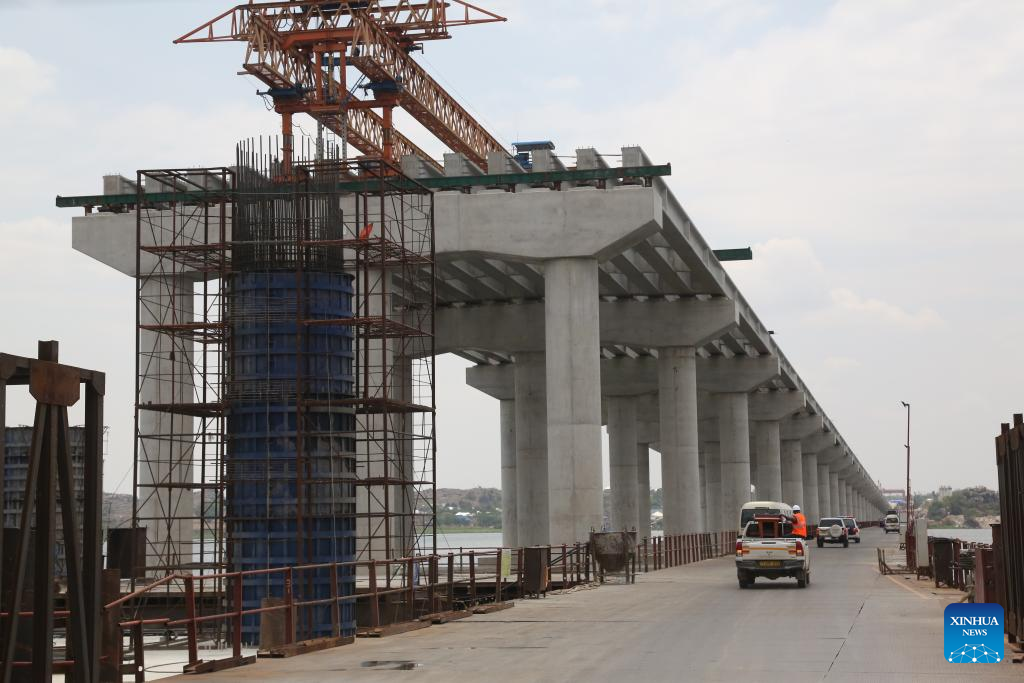
This photo taken on Sept. 9, 2023 shows the construction site of the Magufuli Bridge project over Lake Victoria in Mwanza, Tanzania. Tanzanian members of Parliament say that projects being undertaken under the Belt and Road Initiative (BRI) framework are helping the East African nation to open up its economy.
The MPs made the commendation Saturday during a visit to two major infrastructural projects undertaken by Chinese companies in Mwanza and Shinyanga regions as part of the BRI framework. (Photo by Herman Emmanuel/Xinhua)
DAR ES SALAAM, Sept. 11 (Xinhua) -- Tanzanian members of Parliament say that projects being undertaken under the Belt and Road Initiative (BRI) framework are helping the East African nation to open up its economy.
The MPs made the commendation Saturday during a visit to two major infrastructural projects undertaken by Chinese companies in Mwanza and Shinyanga regions as part of the BRI framework.
Members of the Tanzania-China Parliamentarian Friendship Group visited the construction site of the Magufuli Bridge project over Lake Victoria connecting Mwanza and Geita regions implemented by China Civil Engineering Construction Corporation (CCECC) together with China Railway 15th Bureau, and lot 5 of the standard gauge railway (SGR) from Isaka to Mwanza, implemented by the CCECC and China Railway Construction Corporation Limited (CRCC), the parent company of China Railway 15th Bureau.
Geoffrey Mwambe, leader of the Tanzania-China Parliamentarian Friendship Group, said projects under the BRI framework were helping to support the country's social and economic development. "These projects are also creating employment for local people as well as transferring technology to our local engineers," said the lawmaker.
Mwambe said projects under the BRI framework are well aligned with Tanzania's development visions.
Zhang Junle, the managing director of the CCECC in Tanzania, said the construction of the Magufuli Bridge, named after former President John Pombe Magufuli, has reached 78 percent complete, including 2.48 km of the approach bridge on both sides and 520 meters of the main bridge at the center, adding that more than 1,200 local engineers and skilled workers have been employed for this project.
Zhang said upon its completion, the bridge will be the only extradosed, cable-stayed bridge in the Lake Victoria region, and the longest of its kind in Africa. He said the bridge will shorten the commuting time between Kigongo and Busisi on both sides of Lake Victoria from two hours to five minutes, bringing a permanent solution to the traffic problems haunting the local residents for decades.
"CCECC will ensure deeper participation in the BRI development, and provide better service to the economic and social development of Tanzania in all aspects," he said.
Wang Chao, the CCECC's deputy project manager for the lot 5 Isaka-Mwanza SGR project, said the construction of the Isaka-Mwanza SGR project has led to employing 6,793 local people, including 4,643 local engineers, technicians and skilled labor.
Chen Mingjian, the Chinese ambassador to Tanzania, said the Magufuli Bridge and the SGR project have been listed as key projects of the BRI.
Chen said the SGR project covers 1,950 km, spanning 11 provinces and cities, and connects Tanzania's four economic circles of "two lakes, one port and the capital."
"After completion, it will serve as an important sea channel for neighboring countries such as the Democratic Republic of the Congo (DRC), Uganda, and Rwanda to access the Indian Ocean, and become a transportation artery for the Central East African Corridor," Chen said. "The main idea of the BRI is to improve connectivity, and the main purpose is to achieve win-win cooperation." ■
